You did not ask for the accident, the medical bills, or the time missed from work. But now you’re left trying to make sense of what’s next and what it’s all worth.
Naturally, the first question most people ask is: “How much will I get from my car accident settlement in New York?”
While every case is different, there are clear patterns in how the average car accident settlement in New York is calculated. Injury type, recovery time, and the insurance coverage involved all play a role.
If you are looking for informed guidance based on real outcomes, you are in the right place.
Key Takeaways
- New York car accident settlements vary widely, typically ranging from $15,000 to over $1 million, depending on the severity of the injury, insurance coverage, and liability issues.
- The state’s no-fault insurance covers up to $50,000 for basic medical bills and lost wages but does not cover pain and suffering or long-term damages.
- Serious injuries exceeding no-fault limits, like fractures, traumatic brain injuries, or paralysis, often result in much higher settlements, sometimes reaching multi-million dollars.
- New York’s pure comparative negligence law allows injured parties to recover damages even if they are partially at fault, though their percentage of fault reduces their settlement.
- Reliable documentation of medical bills, lost wages, and accident evidence is critical since insurers only pay for verifiable losses.
- Most car accident cases in New York settle out of court; however, strong legal representation is crucial for maximizing compensation and avoiding costly mistakes.
- Settlement amounts vary significantly by injury type, with typical ranges such as:
- Whiplash: $10,000 to $50,000
- Broken bones: $45,000 to $92,000
- Back and neck injuries: $10,000 to over $1 million
- Traumatic brain injuries (TBI): $100,000 to several million dollars
- Wrongful death cases can reach millions of dollars depending on the circumstances.
- The severity of the injury and recovery time strongly influence the settlement size, with more severe cases typically demanding higher compensation.
- Early and comprehensive evidence gathering, such as photographs, witness statements, and prompt medical treatment can significantly improve a claim’s value.
- Legal assistance helps navigate complex factors, such as insurance policy limits, the threshold for serious injury, and effective negotiation strategies with insurers.
Average Settlement Amounts in New York Car Accident Cases
Your car accident settlement in New York depends on two main things: how badly you were hurt and what kind of claim you’re allowed to file. To get an idea of your potential settlement, you can use a car accident settlement calculator New York to estimate the value of your case. Here’s how the process works:
Average No‑Fault Settlement
New York’s no-fault system provides compensation for immediate economic losses like medical bills, lost income, and necessary services regardless of who caused the crash. These payments are limited and apply only to financial damages, not pain or emotional suffering.
2022 Estimated No-Fault Payouts in New York:
| Covered Expense | Typical Range |
|---|---|
| Emergency medical care | $2,000 – $5,000 |
| Ongoing treatment/therapy | $4,000 – $10,000 |
| Lost wages reimbursement | $1,500 – $6,000 |
| Transportation & essentials | $500 – $1,500 |
| Maximum total payout | $50,000 per person |
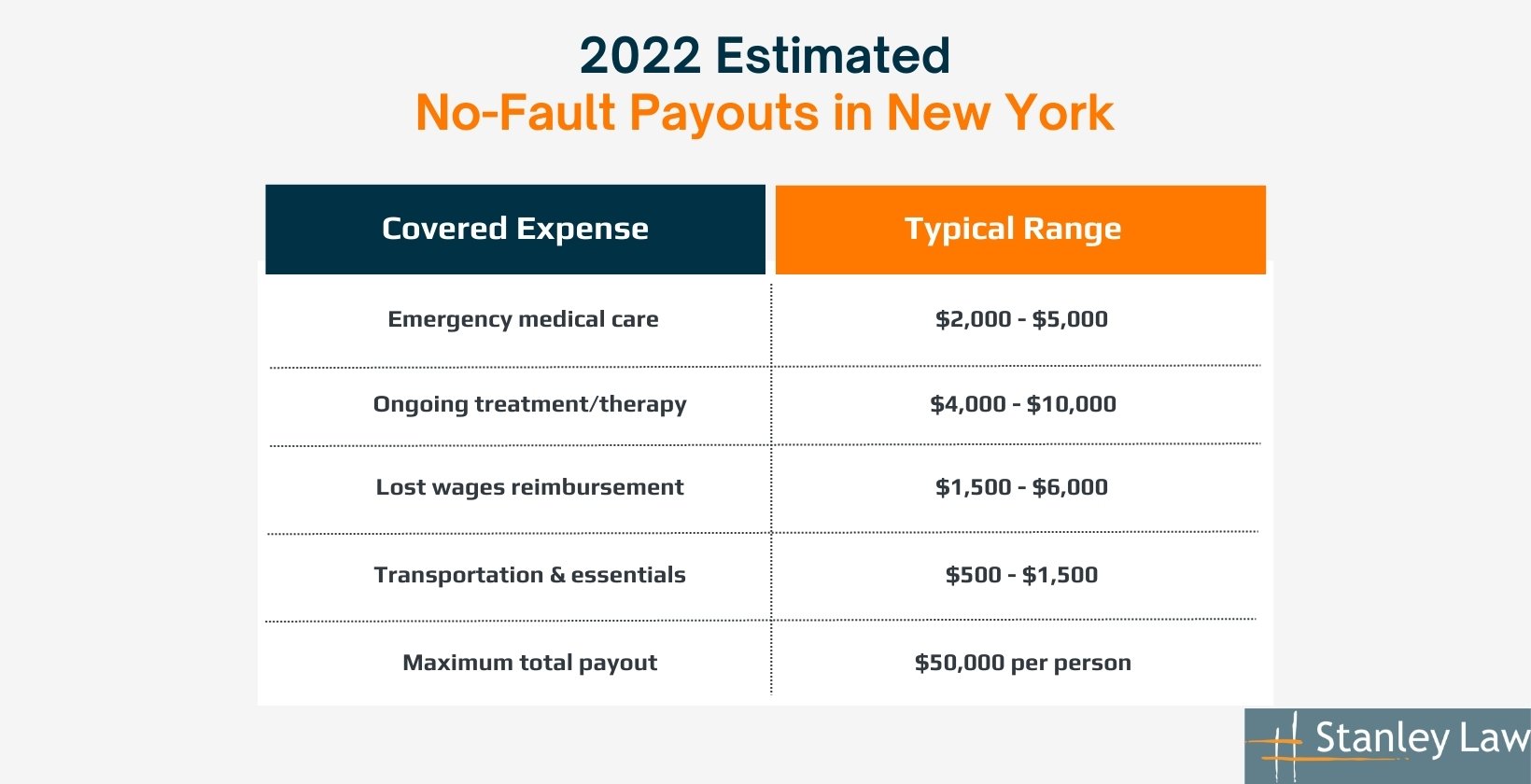
No‑Fault Settlements (PIP Benefits & Limits)
Personal Injury Protection (PIP) is mandatory in New York and is the first form of compensation after a car crash. These benefits are paid by your own insurance, regardless of fault, and are designed to handle immediate, short-term financial losses. How PIP works:
- Covers up to $50,000 per person in total economic losses.
- Pays 80% of lost wages, capped at $2,000/month for up to 3 years.
- Reimburses for transportation to medical appointments.
- Includes essential services like household help.
- Does not cover pain and suffering, emotional distress, or permanent disabilities.
If your total damages go beyond $50,000, or if your injuries qualify as “serious” under New York law, you may be able to pursue a separate personal injury lawsuit for full compensation.
Average Overall Settlements for Serious Injuries
Once your injuries meet New York’s serious injury threshold, your case can go beyond no-fault limits. That opens the door to higher compensation for long-term effects like pain, disability, and income loss.
NY vs. National Average Settlement Ranges:
| Injury Type | Average in NY | National Average |
|---|---|---|
| Fractures, surgeries | $60,000 – $325,000 | $52,900 |
| Permanent disabilities | $250,000 – $750,000+ | $172,000 |
| Catastrophic (e.g., TBI) | $1M – $5M+ | Varies widely |
New York settlements tend to be higher due to more favorable jury verdicts, higher medical costs, and established case law that supports seriously injured plaintiffs.
Settlement by Injury Type
The type of injury you suffer from a car accident directly influences how much your case may settle for. Below are common injury types and typical settlement ranges based on real cases in New York.
Whiplash ($10,000–$50,000)
Whiplash is often underestimated, but severe cases can lead to chronic pain or reduced mobility.
Example 1: Soft tissue neck strain, treated with PT – $12,000 settlement
Example 2: Chronic pain, migraines, reduced motion – $45,000–$50,000
Broken Bones ($45,000–$92,000)
Fractures typically result in higher settlements due to treatment needs and lasting effects.
Key cost factors:
- Surgical repair or hardware insertion.
- Extended rehab or physical therapy.
- Time away from work.
- Pain, scarring, or limited mobility.
Back and Neck Injuries ($10,000 to over $1,000,000)
These injuries range from temporary sprains to life-altering spinal damage.
| Injury Type | Settlement Range |
|---|---|
| Mild sprain/strain | $10,000 – $25,000 |
| Herniated disc (surgery) | $75,000 – $250,000 |
| Spinal cord injury/paralysis | $500,000 – $1.5M+ |
Traumatic Brain Injury (TBI) ($100,000 to several million)
TBIs often lead to lasting emotional, cognitive, and physical impairments.
Case Example: A client who suffered a moderate TBI in a highway crash settled for $2.1M, including lifetime medical care and wage loss.
Death/Wrongful Death (payouts up to several million)
Wrongful death settlements compensate surviving family members for multiple losses. May include:
- Future lost income.
- Medical expenses before death.
- Funeral/burial costs.
- Loss of companionship or guidance.
- Emotional and financial support damages.
Final settlement amounts depend on the deceased’s age, earnings, life expectancy, and number of dependents.
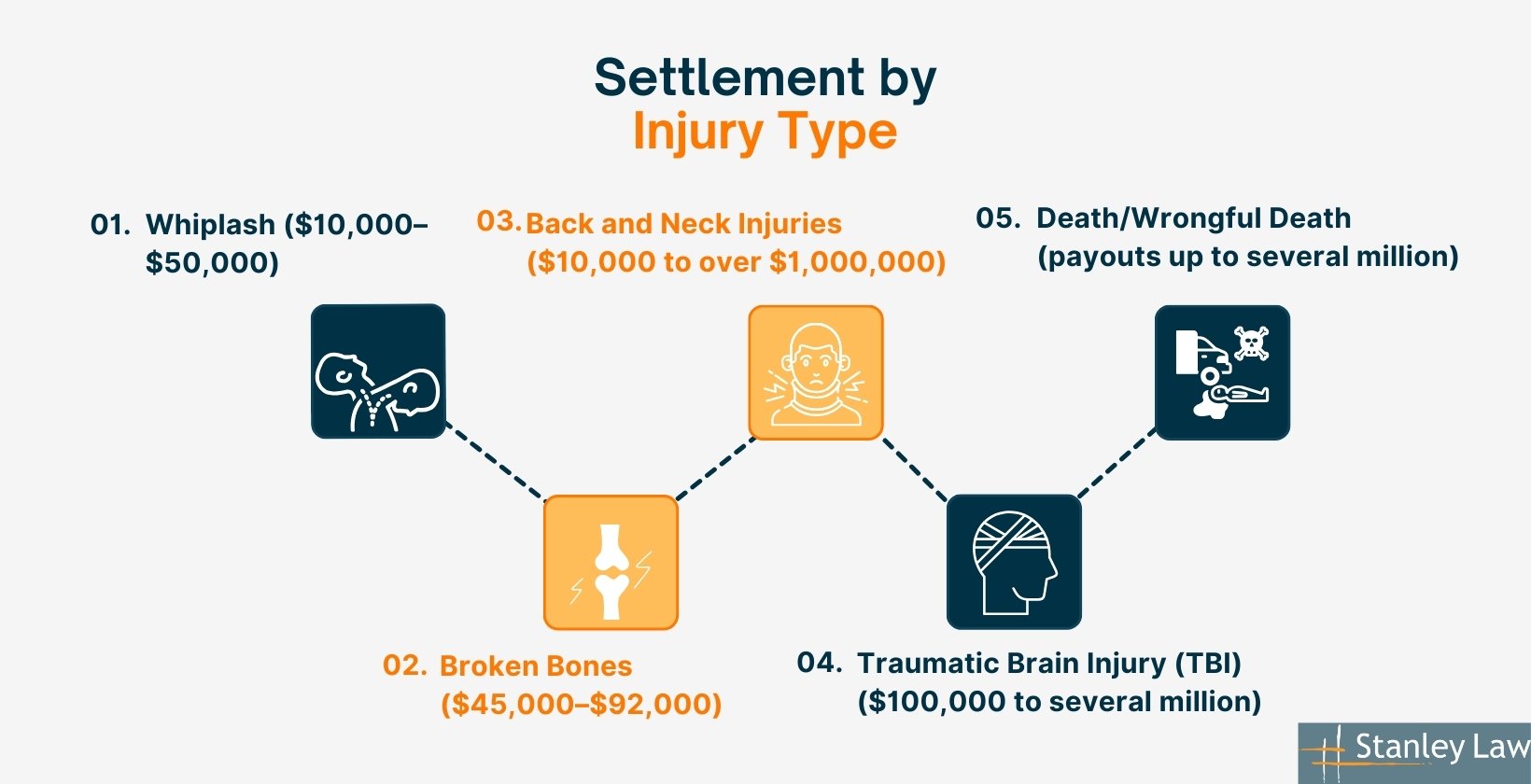
Settlement Ranges by Injury Severity
Injury severity, not just diagnosis, plays a major role in case value.
| Severity | Example Injuries | Settlement Range |
|---|---|---|
| Minor | Bruises, light whiplash | $10,000 – $40,000 |
| Moderate | Fractures, herniated discs | $40,000 – $250,000 |
| Severe | TBI, paralysis, death | $500,000 – $5M+ |
Typical Ranges by Accident Type
The way the accident happened often shapes both the injury and the compensation amount. Certain types of car crashes are more likely to result in severe or complex injuries.
- Rear-End Collision: $15,000 – $75,000
- T-Bone (Side Impact): $50,000 – $500,000+
- Rollover: $100,000 – $1M+
- Pedestrian Struck: $75,000 – $2.5M
- Rideshare (Uber/Lyft): $25,000 – $1M (depends on insurance stack)
- Drunk Driver Involved: $100,000 – $2.5M (may include punitive damages)
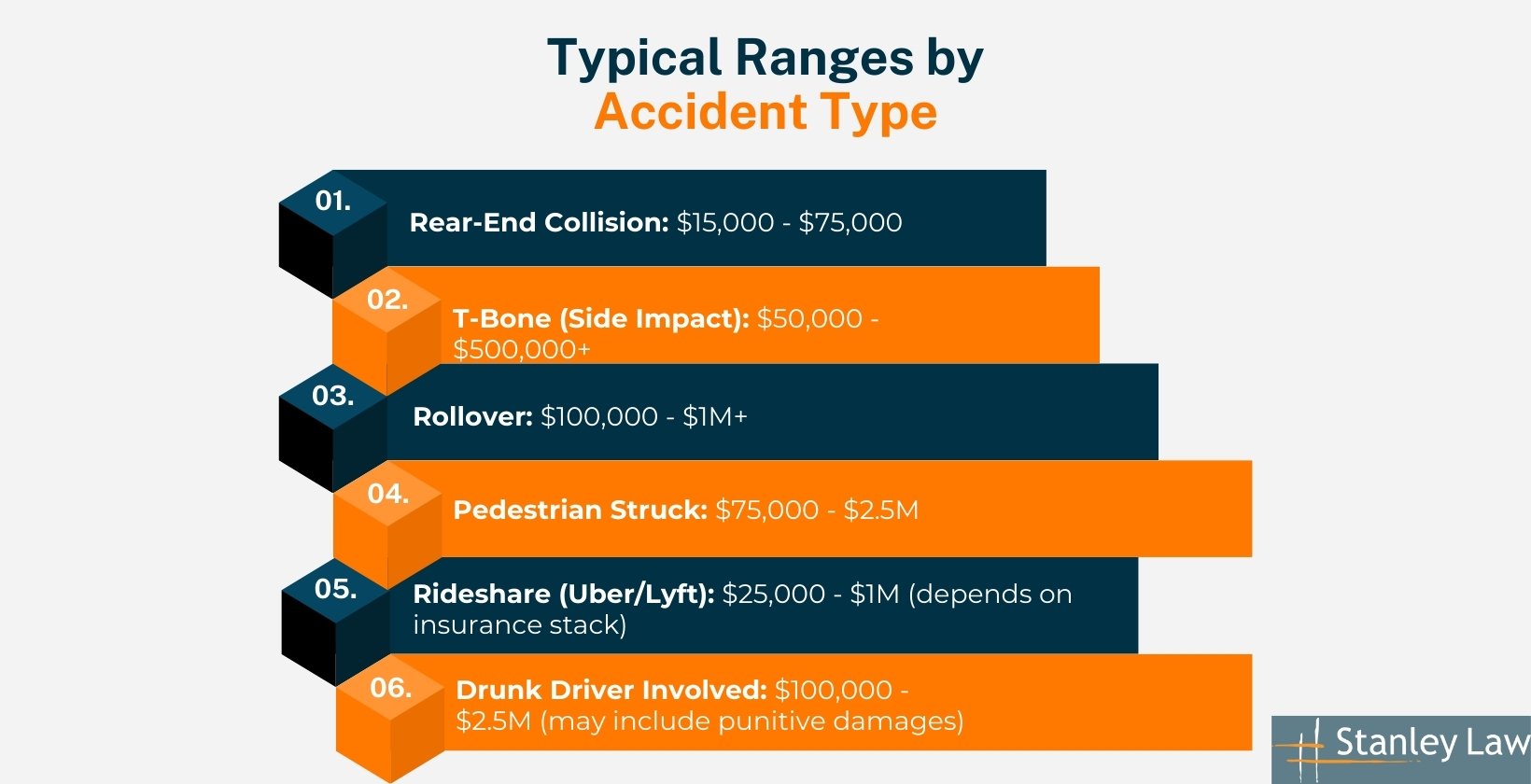
Factors Influencing Settlement Amounts
Not all settlements are created equal; two people injured in the same crash can walk away with very different results. That’s because your compensation depends on several key factors, from the severity of your injuries to how well you document the case.
Severity of Injuries & Recovery Time
In general, the more serious the injury and the longer the recovery, the higher the settlement.
| Injury Severity | Common Injuries | Medical Costs | Settlement Range |
|---|---|---|---|
| Minor | Bruising, whiplash, light sprain | $500 – $5,000 | $10,000 – $40,000 |
| Moderate | Fractures, torn ligaments | $10,000 – $50,000 | $40,000 – $250,000 |
| Severe | TBI, spinal injuries, disability | $100,000+ | $500,000 – $5 million+ |
Even within the same injury category, recovery time and treatment complexity can shift the final amount by thousands or hundreds of thousands.
Economic vs Non‑Economic Damages
New York law allows accident victims to recover two main types of damage: economic and non-economic.
| Type | What It Covers | Proof Often Needed |
|---|---|---|
| Economic | Surgery bills, rehab costs, lost income | Bills, invoices, pay stubs |
| Non-Economic | Pain, anxiety, and reduced enjoyment of life | Medical records, therapy notes, journals, testimony |
Economic damages are easier to verify; they’re based on numbers. Non-economic damages require strong legal framing and documentation to justify.
No‑Fault Law & Serious Injury Threshold
New York’s no-fault system covers up to $50,000 for medical costs, lost wages, and services, but only if your injuries remain within that limit. To go beyond no-fault and sue for full compensation, your injuries must meet the serious injury threshold, which includes:
- Broken bones
- Permanent or significant loss of function
- Visible disfigurement
- Disability lasting 90 of 180 days post-accident
Meeting this threshold is what allows you to pursue pain and suffering damages in court.
Comparative Negligence (Pure)
In New York’s pure comparative negligence system, even if you’re 90% at fault, you can still recover 10% of the damages. Your settlement is reduced by your percentage of responsibility.
Sample Settlement Reductions:
| Your Fault % | If the Claim is Worth $100,000 |
|---|---|
| 0% | $100,000 |
| 25% | $75,000 |
| 50% | $50,000 |
| 75% | $25,000 |
Insurance Policy Limits & Coverage Gaps
No matter how strong your case is, the other driver’s insurance coverage puts a ceiling on how much you can recover, unless other policies kick in.
In New York, the minimum required coverage is:
- $25,000 per person for bodily injury
- $50,000 per accident
- $10,000 for property damage
In serious cases, uninsured/underinsured motorist (UM/UIM) coverage can be the only way to collect full compensation if the at-fault party is underinsured.
Example: If your damages are worth $400,000, but the at-fault driver’s policy only covers $50,000, the rest is only recoverable if there’s extra insurance coverage involved.
Quality of Evidence & Documentation
Insurance companies don’t pay based on what happened; they pay based on what you can prove. Knowing what to do after a car accident can make all the difference in building a solid case for your claim. The more thorough your documentation, the stronger your position.
Collecting Photos, Witness Info & Scene Details Immediately
Immediately after the car crash, gather as many details as possible. This information often makes or breaks a liability case.
What to document:
- Photos of all vehicles and visible injuries.
- Road conditions, traffic signs, and weather.
- Names and numbers of witnesses.
- Police report or officer badge number.
Seeking Medical Treatment Within 72 Hours
Delays in treatment weaken your case. Even if you “feel fine,” symptoms may develop, and insurers look for gaps.
Example: Getting checked the same day supports your claim. Waiting even a few days gives the insurer room to deny or delay the claim.
Preserving Records: Medical, Wage, Accident Reports
An accurate and organized document helps to prove the financial, physical, and professional costs associated with the accident. Build a file with:
- All medical bills and treatment notes.
- Pay stubs showing lost income.
- Out-of-pocket expenses (transport, medication).
- Insurance letters, claim denials, and offer letters.
- Police reports, citations, or diagrams.
The more detailed your documentation, the harder it becomes for an insurer to dispute your claim.
Social Media Caution (Avoid Undermining Your Claim)
What you post online can harm your claim, even if it’s an innocent picture.
For example, a claimant recovering from a back injury posted a photo from a birthday party smiling, standing, and appearing fine. The insurer used that one image to argue the injury wasn’t serious, cutting the final settlement offer by nearly 40%.Until your case is closed, keep profiles private or stop posting entirely.
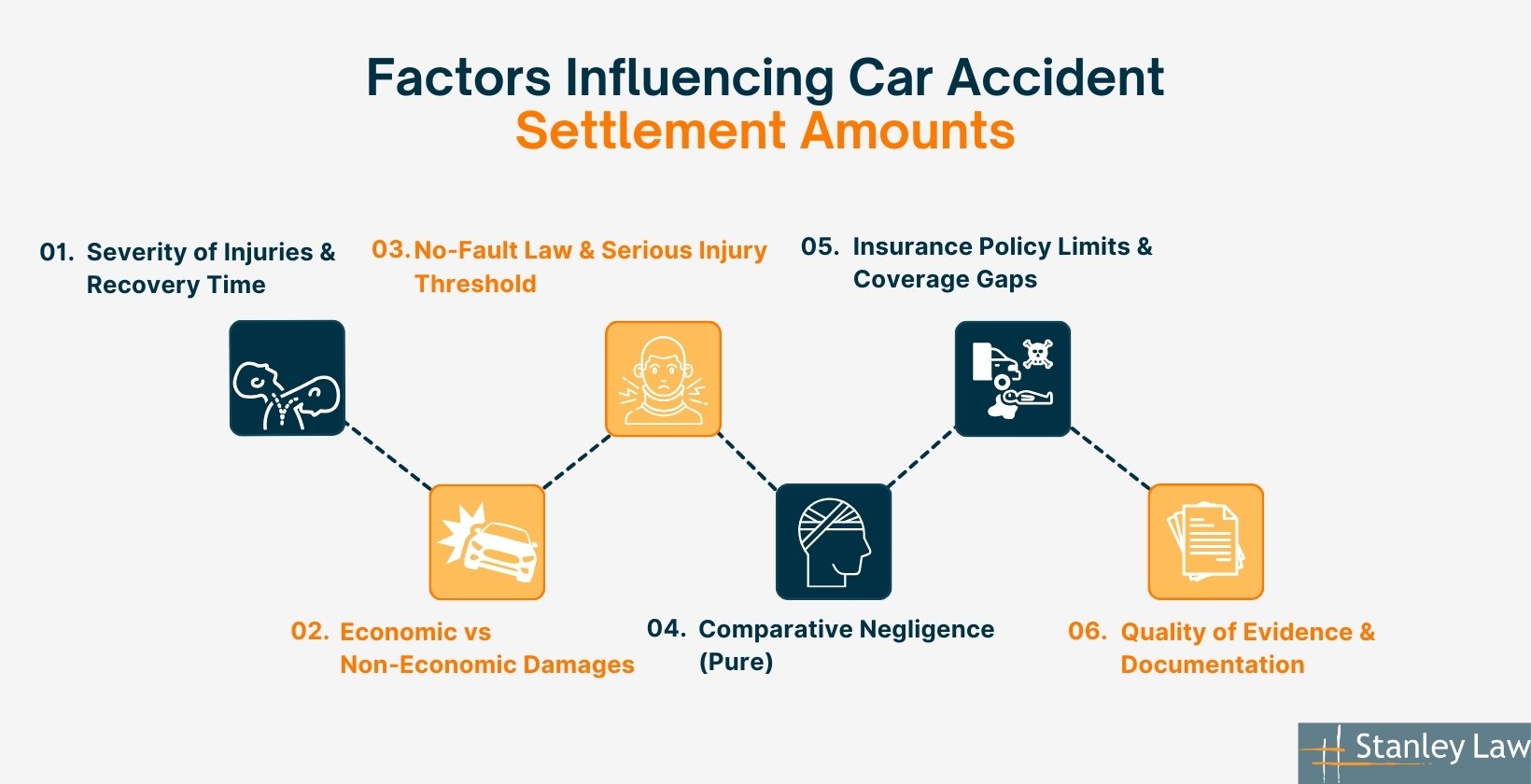
How Insurers and Lawyers Calculate Settlement Value in New York?
Assigning a dollar value to your claim isn’t just about medical bills. Insurers and attorneys use a mix of methods, some based on hard numbers, others on legal precedent and negotiation leverage. Understanding how these methods work can help you recognize whether a settlement offer is fair.
Multiplier Method for Pain & Suffering
Pain and suffering damages are often calculated using a multiplier method. Insurers multiply your total financial losses by a number (usually between 1.5 and 5) based on the impact of your injuries. The multiplier depends on factors like:
- The length and difficulty of recovery.
- Whether pain limits your daily activities.
- How permanent is the damage?
- The emotional and mental toll the injury caused.
What matters most:
This isn’t a strict formula. A top NY car accident attorney can argue for a higher multiplier by showing how the injury disrupted your work, relationships, and long-term well-being beyond just the physical pain.
Special Damages Based on Bills and Financial Records
Special damages like lost wages, treatment costs, and out-of-pocket expenses form the base value of your claim. What strengthens their impact in negotiation:
- Detailed records and receipts
- Ongoing treatment or future care estimates
- Proof of wage loss from employers or tax documents
- Consistent medical follow-ups (no gaps in care)
Influence of Legal Precedent and Case Law in Value Estimation
Attorneys don’t just look at your bills, they look at your county. Settlement values often vary based on how similar injuries were handled in your local courts.
Example: A herniated disc case might settle for $250,000 in Manhattan, but $90,000 in a rural county with conservative juries.
Attorneys use prior verdicts and settlements to:
- Set benchmarks during negotiations.
- Justify higher compensation based on local precedent.
- Predict how a jury may respond if the case goes to trial.
This legal context becomes especially valuable in serious injury cases where pain, disability, or long-term care are involved.

How to Maximize Your Car Accident Settlement in New York?
Insurance companies don’t just look at what happened; they look at how well you handled it afterward. A higher payout often comes down to the steps you take in the first few days, and how well your case is presented when it’s time to negotiate. Here’s how to give your claim the strongest possible foundation:
Building a Strong Claim from Day One
What you do in the first 24–48 hours can shape your entire case. Insurers watch for fast reporting, proper documentation, and clear medical records. Here’s what to focus on immediately:
- Report the accident to the police and your insurance carrier right away.
- Get medical care, even if you feel okay initially.
- Photograph the scene, vehicle damage, and visible injuries.
- Get contact info from witnesses and first responders.
- Contact a New York personal injury attorney before talking to the other driver’s insurance company.
These early actions can help preserve key evidence and reduce the risk of errors or lowball offers later.
Preserving Documentation and Records
You don’t need fancy paperwork, just organized, complete records that show how the accident has affected your health, income, and daily life. Build a simple but complete file:
- Medical bills and treatment summaries.
- Pharmacy receipts and transportation costs.
- Pay stubs and employer notes showing missed work.
- Follow-up instructions or future treatment plans.
- Copies of insurance communications or settlement offers.
Working with Experts (Doctors, Economists, Accident Reconstructionists)
In moderate to severe injury claims, expert opinions can significantly raise your settlement value by explaining long-term consequences and clarifying liability. Types of experts that may support your case include:
- Medical specialists, who explain the severity and long-term effects of your injuries.
- Vocational experts who assess how your injuries affect your ability to work.
- Economists, who estimate future medical needs and lost earning capacity.
- Accident reconstructionists provide technical insight into how the crash occurred.
Expert reports add credibility and authority to your claim and often force insurers to negotiate more seriously.
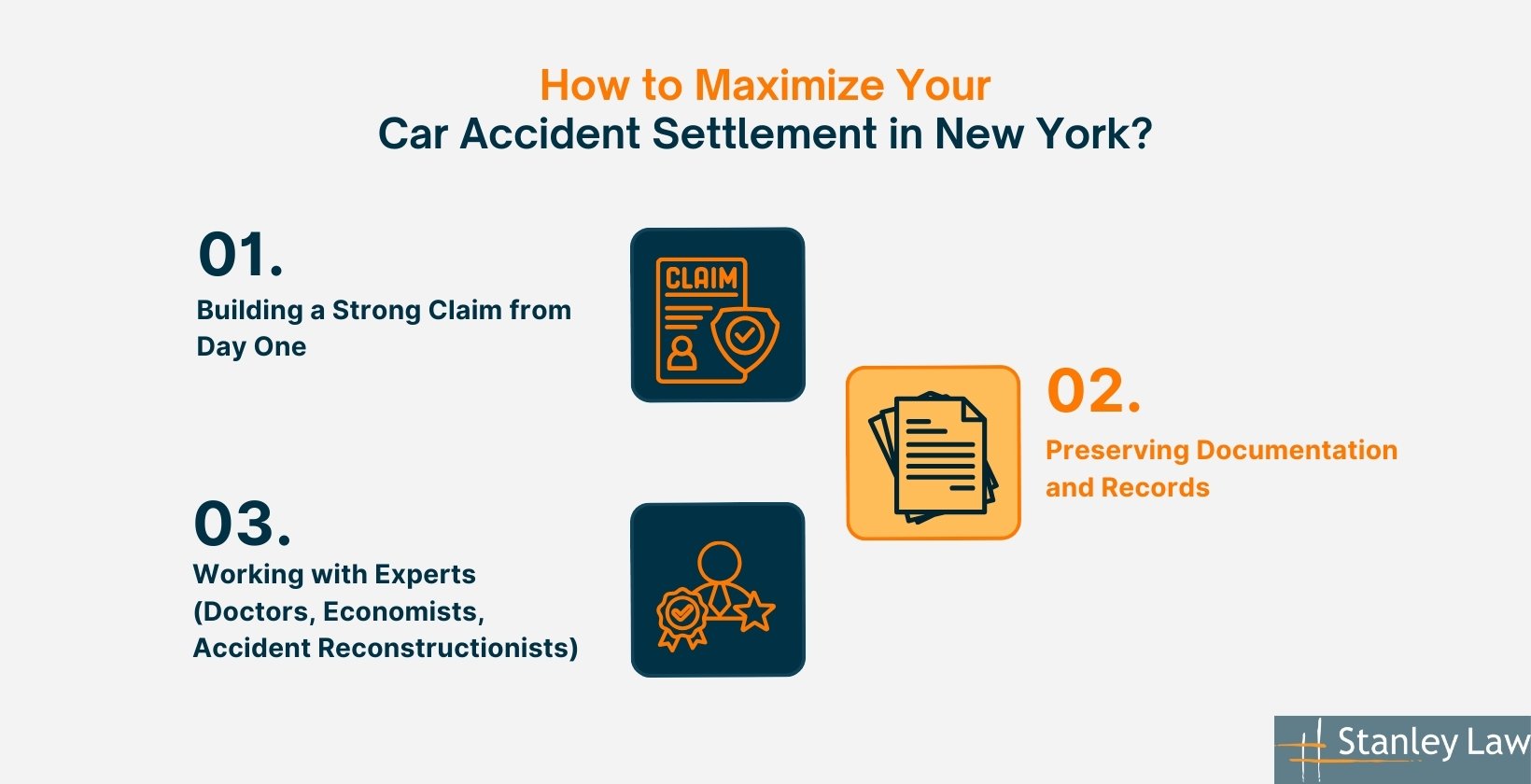
Legal and Procedural Context for Settlements
Every car accident settlement in New York is shaped by the legal system it lives in, including deadlines, jury trends, and rules around compensation. Knowing the basics of these legal boundaries can help you avoid costly mistakes and understand where your case may end up if it doesn’t settle early.
Statute of Limitations
In New York, you have three years from the date of the crash to file a personal injury lawsuit. Miss this deadline, and your claim will likely be dismissed, no matter how valid it is. A few exceptions apply:
- Minors: Time doesn’t begin until their 18th birthday.
- Claims against government entities: You must file a Notice of Claim within 90 days, and the lawsuit within one year and 90 days.
- Wrongful death cases: Must be filed within two years of the person’s death, not the date of injury.
It’s always safer to act early. Even if you are still recovering from your injuries, consulting with an attorney early helps protect your rights and options.
Median Jury Verdict Amounts in New York
Even if your case never goes to court, jury verdicts shape how insurers negotiate. Payout expectations often follow local verdict trends. Here’s a general comparison of median jury verdicts:
| Location | Median Award (All Injury Types) |
|---|---|
| New York (statewide) | $287,000 |
| National Median | $85,000 |
These numbers don’t guarantee your result, but they reflect how urban juries, especially in NYC, often award more in serious injury cases.
Role of Jury Verdicts vs Settlements
Most cases in New York settle out of court and for good reason. Settlements are faster, less stressful, and more predictable.
Do you know when a car accident goes to court? This typically happens when there are significant disputes over liability or when the damages are large and can’t be resolved through settlement.
| Approach | How It Works | Key Considerations |
|---|---|---|
| Settlement | Negotiated an agreement before the trial | Faster, more predictable, less public. |
| Jury Verdict | A decision made by a jury after a courtroom trial. | Riskier, often higher payouts in serious cases. |
Insurance companies prefer settlements to avoid trial risks, but when liability is disputed or damages are large, going to trial may be worth it.
Punitive Damages in NY (Rare)
Punitive damages aren’t about compensation; they’re about punishment. In rare cases, New York juries may award extra damages to penalize reckless or malicious conduct. These awards require:
- Clear evidence of gross negligence or intentional harm.
- Circumstances far beyond ordinary negligence.
Example: A drunk driver with prior DUIs causes a serious crash. The jury awards punitive damages to punish the behavior, not just cover the victim’s losses.
Why Legal Representation Matters in NY Car Accident Cases?
Hiring a skilled car accident attorney can significantly improve the outcome of your case. From the start, legal guidance helps you avoid costly mistakes, gather stronger evidence, and secure the compensation your injuries truly deserve. The reasons to get a lawyer after a car accident include protecting your rights, navigating the insurance process, and ensuring you receive the full compensation you’re entitled to.
Evidence Gathering & Fault Negotiation
Settlement value depends on verifiable evidence, not just the circumstances of the crash. An experienced lawyer knows what matters most and when to present it.
Lawyers handle:
- Medical records and treatment notes to prove injury severity.
- Witness statements to support your version of events.
- Accident scene photos and police reports to establish liability.
- Expert opinions from doctors, accident reconstructionists, or economists.
- Communication logs with insurers or involved parties.
Maximizing Damages via Documentation & Legal Strategy
Insurers often undervalue claims unless challenged. An experienced lawyer builds leverage by using your documentation, expert opinions, and legal tools to demand a full, fair payout. Attorneys increase your recovery by:
- Identifying when insurers are stalling, delaying, or acting in bad faith.
- Applying pressure through policy timelines and legal obligations.
- Arguing for future costs, not just short-term medical bills.
Example: A client offered less than their ER costs received 3x more after we presented evidence of delayed responses and flagged insurer misconduct.
Avoiding Mistakes & Insurance Tactics
Even simple missteps can reduce your settlement. Insurers watch for anything that undermines your claim and use it to their advantage. Common mistakes that lawyers prevent:
- Giving recorded statements without legal guidance.
- Accepting the first settlement offer.
- Failing to document ongoing care or lost income.
- Signing forms that release future claims.
- Waiting too long to act, risking missed deadlines.
From the beginning, an attorney helps you avoid traps that can quietly weaken your case and makes sure your side is heard clearly and on time.
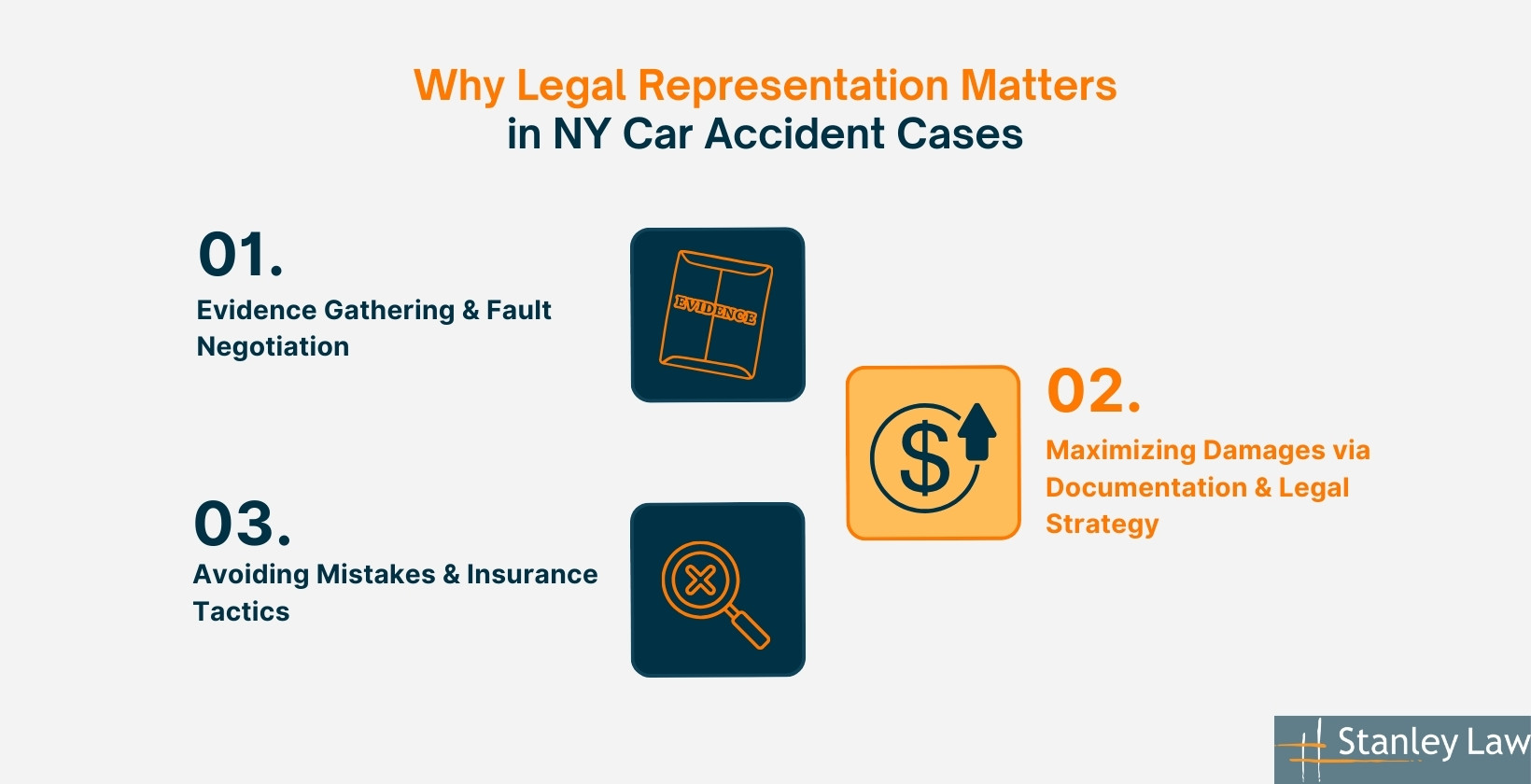
Post‑Settlement Considerations
Resolving your case through a settlement is a big step, but it’s not the last. After signing the agreement, your final payout goes through a few standard steps involving deductions, liens, and legal details that may affect your net amount. Knowing what happens next helps you avoid confusion or surprises.
Deductions & Liens
Your actual payout, the amount you take home, is calculated after subtracting several required costs related to your case. These deductions are standard and necessary in nearly every personal injury settlement. Common deductions include:
- Attorney’s contingency fee (typically one-third of the settlement).
- Outstanding medical bills not yet paid by insurance.
- Health insurance or Medicaid liens, where providers seek repayment.
- Legal case expenses, such as expert fees or court filing costs (if applicable).
Before any funds are released, your attorney will provide a full breakdown. You’re entitled to transparency at every step.
Tax Implications & Confidentiality Agreements
Most personal injury settlements in New York are not taxed, but there are a few important exceptions. It’s important to understand which parts of your settlement are protected and which are not. Here’s what to know:
- Non-taxable: Compensation for physical injuries, medical expenses, or pain and suffering
- Taxable: Punitive damages, interest earned on the settlement, or any portion unrelated to physical harm
Some settlements may include a confidentiality clause, especially in high-value or sensitive cases. This clause restricts you from disclosing the terms of the agreement, and violating it could result in penalties. Your attorney will walk you through any tax concerns or confidentiality language before you sign.

How Long Does It Take to Settle a Car Accident Case in NY?
There’s no one-size-fits-all timeline for a car accident settlement in New York. The process can be quick in simple cases, or take over a year when injuries are serious or liability is unclear.
Simple vs Complex Cases
The biggest factor in settlement time is the complexity of your claim. Cases with clear injuries and straightforward liability usually move faster than those with deeper disputes or extensive medical care. Typical timelines look like this:
- Minor injury claim: 3-6 months (example: rear-end accident with whiplash and no ongoing treatment).
- Moderate injury case: 6-12 months (example: broken bones, physical therapy, return to work within a few months).
- Severe injury or liability dispute: 12-18+ months (example: spinal damage or a multi-vehicle crash where fault is unclear).
Impact of Medical Recovery on Settlement Time
Most experienced attorneys won’t push to settle your case until you’ve reached Maximum Medical Improvement (MMI), the point where your condition has stabilized, even if it’s not fully healed.
Why? Because settling too soon means future medical costs or lasting impairments might not be accounted for, and once you settle, you can’t go back.
Example: If your doctor recommends surgery months after the crash, your attorney will likely delay negotiations until after recovery, ensuring that all expenses and long-term effects are factored into the final amount.
Delays Caused by Insurers or Court Proceedings
Even well-documented cases can hit delays due to insurer tactics or the legal system’s slowdowns. Some delays are strategic, while others are simply procedural. Common causes of delay include:
- Insurer’s stall tactics, like “investigating” for months without response.
- Lowball offers that require back-and-forth negotiations.
- Scheduling issues with medical evaluations or depositions.
- Court-related holdups, including motions, hearings, or trial calendars.
At Stanley Law Offices, our experienced attorneys know how to move things forward, apply pressure when needed, and avoid unnecessary holdups that can drag cases out.

Frequently Asked Questions About Car Accident Settlements in New York
What qualifies as a “serious injury” under NY law?
A “serious injury” under NY law is defined as a fracture, disfigurement, permanent limitation of a body part, significant loss of function, or being unable to perform daily activities for at least 90 of the first 180 days after the accident.
Is it safe to accept the first offer?
No, it’s rarely safe to accept the first settlement offer in an NY car accident case. Early offers are usually low and don’t account for full medical costs or long-term effects.
What if the insurance company denies my claim?
If your car accident claim is denied in NY, you can challenge it by submitting new evidence, requesting reconsideration, or filing a lawsuit with an attorney’s help. A denial doesn’t mean your case is over.
Do all car accident claims go to trial?
No, most New York car accident claims do not go to trial. The majority are resolved through out-of-court settlements unless liability or damages are strongly disputed.
Find Out What Your New York Car Accident Case Is Really Worth
No two car accidents are the same, and neither are the settlements. The value of your claim depends on your injuries, recovery time, supporting evidence, and how New York law applies to your case.
Online averages can offer estimates, but only a qualified attorney can evaluate the real value of your specific case.
At Stanley Law Offices, our attorney, Joey Stanley and the legal team help injured New Yorkers understand their rights and secure the compensation they deserve, not just what the insurer offers. Your claim deserves more than guesswork. Let us review your case and explain your options clearly, confidentially, and at no cost.
Start with a free consultation. It’s quick, it’s easy, and it could make all the difference. You pay nothing unless we win your case.

